#bright pink lychnis
Text
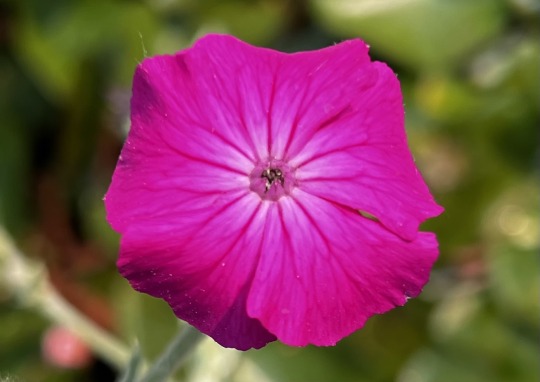
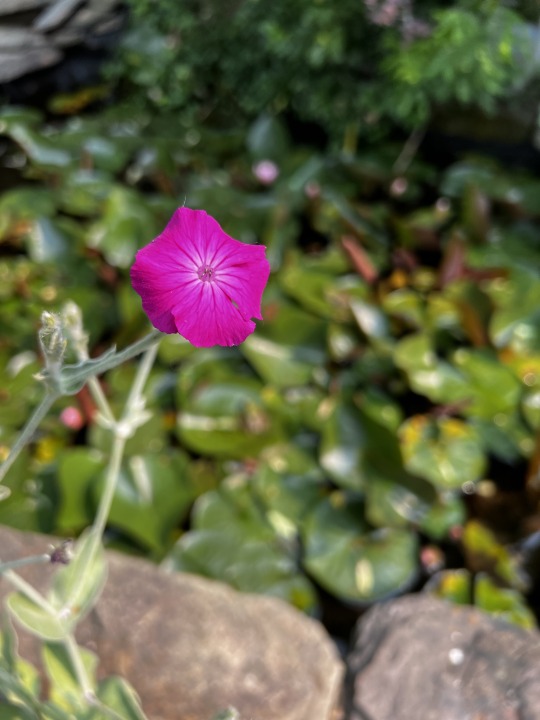
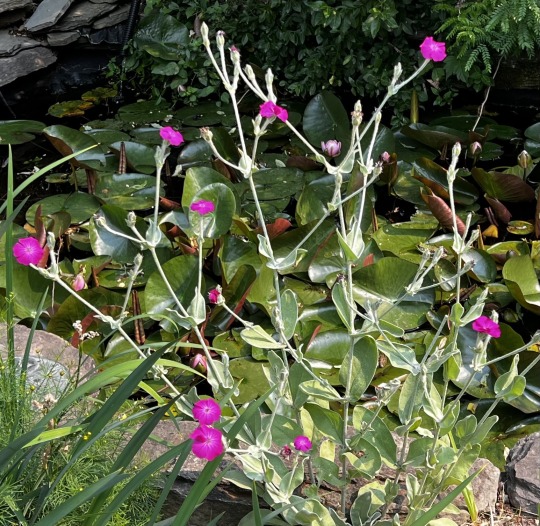
Lychnis coronaria, Rose campion, Bachelor’s button, Robin Hood, Catchfly, Mullein pink, Dusty miller, Bloody william, Lamp-flower. What an interesting list of names. You wonder why some flowers get so many common names.
The scientific name comes from the Greek lychnos, meaning “lamp,” referring to the use of the wooly leaves as lamp wicks. The most common common name, Rose campion, supposedly comes from the use of flowers to make garlands for athletic champions. I have tried to figure out why it is called Bloody william, and the only such moniker I could find happens to be that of a rather despicable man named William Anderson, pictured below, an anti-Unionist, who was nicknamed Bloody William for his sadistic escapades in the battle for our beloved Lawrence, Kansas.
The plant is one I look forward to every June. Its leaves are a dull grey and hardly worth a look but the flowers are a bright pink or a pinkish rose. They are almost luminescent. They each have five petals but the petals are so close together as to be indistinguishable from a whole. The hue gradually lightens from the outside in, ending in a splash of white, which also gives the flower its shine. In the middle is a tiny basket of dark pistils and stamens. Again, the effect is to create blooms that almost glow in the dark.
Perhaps for that reason, the Catholic Church has dedicated Lychnis to St. John the Baptist and the text in which he is described as “a light to them which sit in darkness.” The striking flower is said to be lighted up for St. John on June 24th, St. John’s Day, though mine usually bloom the first week in June.
John seems to be a figure popular with ancient gardeners looking for common names to supplant the more difficult scientific names. John was a Jewish Rabbi whose name was originally Yokhanan HaMatbil, . יוחנן המטביל. He famously baptized Jesus in accordance with the practice of the ancient Jewish sect, the Essenes. Some say Jesus was a follower of John, not the other way around. He was beheaded on August 29, the day the leaves of St. John’s Wort develop red spots.
Rose campions are supposed to be short-lived but they self-sow easily. We have had consistent blooms since the summer of Sara’s wedding when I bought plants that were scheduled to bloom in time for the event. They grow around the pond and you can see in the photo how the bloom blends perfectly with the color of the blooming water lilies. If you look closely, you can see an out of focus frog on a water lily just beneath the flower in the photo. You can see him in focus below Bloody William and another frog two lilies up.

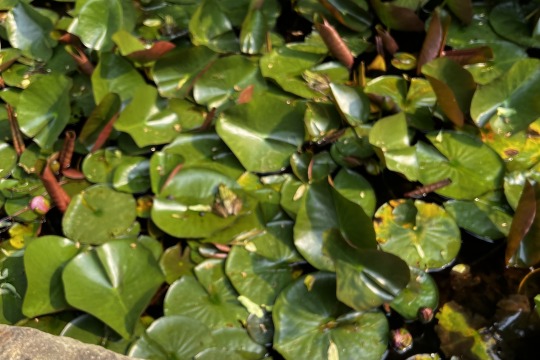
0 notes
Photo




A NEW MAJOLICA PLATE AND FLOWERS FROM THE GARDEN
Yesterday was quite hot so I went around the garden and quickly picked a few things, and equally quickly put them in a vase as I was going out. At a local vintage shop I found this interesting German majolica plate which brightened my day no end.
#German majolica plate#dahlia#old rose#'Mother's Love' pink rose#blue scabiosa#bright pink lychnis#pasque flower foliage#hellebore leaf
5 notes
·
View notes
Text
Benrey knew about bouquets theoretically.
They were what the winners got in some sports games, and they were bought by sitcom boyfriends when they’d fucked up with their girlfriends. They were bundles of flowers that held some kind of meaning that was really beyond Benrey.
The thing was, he never saw one in person until months after they’d all made it out of Black Mesa. They were all at the Boomer household, throwing them an anniversary party. No one was quite sure if it was their one year anniversary or fiftieth anniversary -- neither of them would give anyone a clear answer -- but Bubby had presented his husband with an enormous bouquet of flowers, trying and failing to appear like anything but a sappy fool.
Benrey was fascinated by it.
Xen didn’t have flowers. There were plant-adjacent things, sure, but most of them tried to stab passersby or emitted poisonous gasses. Benrey was sitting on a barstool next to the bouquet in its vase on the countertop, and he had yet to be stabbed by the dethorned roses, and the sprigs of lavender didn’t emit anything except a soothing scent that reminded him of the hand lotion Gordon wouldn’t let him eat. He gently ran his fingers over the layers of carnation petals while Coomer spoke beside him.
“-language of flowers was introduced to England in the early 18th century by Mary Wortley, Lady Montague, whose husband was Ambassador to Turkey. By the Victorian era, almost every-”
“Flowers have a language?” Benrey said, looking up and zoning back into the Wikipedia infodump.
“Yes!” Dr. Coomer informed him brightly. “Floriography (language of flowers) is a means of cryptological communication through the use or arrangement of flowers. Meaning has been attributed to flowers for thousands of years, and some form of floriography has been practiced in traditional cultures throughout Europe, Asia, and Africa. In Western culture, William Shakespeare ascribed emblematic meanings to flowers, especially in Hamlet, Prince of Denmark. Similarly, in a scene in his Henry VI, Part 1, English noblemen pick either red or white roses to symbolize their allegiance to the Houses-”
“So different colors have different meanings? Like, uh. Like Sweet Voice?”
“Yeah!” Tommy answered him this time, Dr. Coomer too busy telling the rest of them about Victorian flower meanings. “And- And each kind of flower has a different meaning too. It’s like a whole language!”
Benrey stared at the bundle of flowers in front of him. He sang out a Sweet Voice note the exact shade of one of the scabiosas and smiled.
He didn’t tell anyone his plan when he started. Something told him that would ruin it somehow. It felt more meaningful to have it be a surprise. He did his research in private. Wikipedia may be gone, but there were still plenty of websites eager to inform him of all the strange meanings Victorians applied to flowers. (What the hell was “assiduous to please” supposed to mean?) He stayed up after Tommy and Gordon had gone to bed, and sang notes of Sweet Voice as softly as he could, searching for the right correlations between flowers and Sweet Voice colors.
A bouquet arrived on Bubby and Coomer’s doorstep first. Cheerful American starworts and chrysanthemums wrapped in convolvulus, accompanied by sprigs of larch and black poplar. (White like sagebud to misty golden, you’re a bold one. Morning glory, I’m glad you got through this story. Black poplar to yellow larch, I’ll follow where you charge.) Bubby was wildly confused by its appearance, but the next time he saw them, Coomer took Benrey under his arm and gave him a noogie that would’ve drilled a hole into anyone else’s skull.
Gordon and Tommy’s came next, and Benrey made sure they arrived at the same time. Gordon was the one to find them, having opened the door to two bouquets addressed to the two of them. “Uh, Tommy?” He called out over his shoulder, picking up his bouquet and examining it. Bright Peruvian heliotropes peered out from between hundred-leaved roses and pencil-leaved geraniums, all surrounded by southernwood and Irish ivy. (Purple as heliotrope, you give me hope. Geranium to rosy pink, I’ll love you forever, I think. Green as ivy and southernwood, for you, I’ll be good.) “Do you know anything about this?”
“No,” Tommy said, walking up behind him and peering over his shoulder. When Gordon stepped aside for him, he scooped up his bouquet too. His was entirely made of flowers, a bright splash of color: the warm colors of the red periwinkles and scarlet lychnis offset by the American cowslips and traveller’s joys. (Scarlet, with you, my worries I forget. Purple like cowslip, I think you’re smart as a whip. White, you make my life bright.) “Benrey, do you- did you do this?”
“Nah, man.” Benrey shrugged, hands in his pockets. “Y’all must have, uh. Some kinda secret admirer, or something.”
Tommy stared at him for a long moment, and Benrey could swear he saw the wheels turning in Tommy’s head, but if he was going to say anything, he was distracted by Gordon ushering them into the kitchen to find vases.
He was hunched over his laptop that night again, trying to figure out if he could feasibly make a tiny arrangement of sorrel, bearded crepis, and juniper to put on Joshua’s bedside table (Green to juniper blue, I’ll protect you. Yellow, I’m proud of this tiny fellow) without Gordon accusing him for bringing weeds in the house, when a voice broke the relative silence of the living room.
“Ben?” Gordon said groggily. Benrey jumped in his seat and sang out a string of surprised teal. “You’ve been coming to bed late like every night this week, what’s up.”
“Uh, nothing. Just… browsing. Making deals on… eBay.” Benrey bluffed. Gordon squinted at him, clearly not believing the lie, then glanced at the laptop screen.
“Are those flowers?”
“...What are flowers.”
Gordon snorted and draped himself over the back of the couch. “I fucking knew it. You’re not sneaky, dude.”
“I don’t know what you’re talking about. What are flowers.”
Gordon flicked the side of his head. “Why were you keeping the bouquet thing a secret?”
“I dunno.” Benrey looked away, embarrassed. “Thought it’d be a fun surprise.”
Gordon chuckled and leaned in to kiss his cheek. “I never expected you to be the sentimental type.”
“Didja like them, though?” Benrey looked up, hopeful.
“Obviously. I put them on the kitchen table, they’re beautiful.” Gordon straightened up and reached for Benrey’s hands. “Now c’mon, Gordon want cuddles.”
“Gordon want cuddles? Cuddles from Benrey?” Benrey teased, taking Gordon’s hands and standing. “What about Tommy?”
“Tommy also want cuddles. He’s the one who told me to go get you.” Gordon said, pulling him up the stairs to their room. “Also, he figured out the flower meanings. Why the hell is there a plant for bantering?”
“The Victorias knew banter is important to any relationship, man. It’s like you don’t even understand enemies-to-lovers, smh.”
“Stop saying abbreviations out loud.” Gordon laughed, shoving him into bed, where Tommy sleepily grabbed him.
The following afternoon, Benrey found a vase of roses addressed to him, alongside several seed packets.
#hlvrai#frenreylatta#benrey#I'm not gonna tag the others bc they're barely in it but they're all there#my writing#okay to reblog#I wrote this in a rush today because the idea would not leave me alone!!!!!#shoutout to people who regularly come up with sweet voice rhymes bc that was HARD#most of these are a stretch but I wanted to make them work with the flowers#the flower meanings come from a flower language book I have and the meanings are as follows:#american starworts: cheerfulness in old age#chrysanthemum: cheerfulness under adversity#convolvulus: bonds#larch: boldness#black poplar: courage#peruvian heliotropes: devotion#hundred-leaved roses: dignity of mind#pencil-leaved geraniums: genius#southernwood: banter#irish ivy: clinging affection#red periwinkles: early friendship#scarlet lychnis: sunbeaming eyes#american cowslip: divine beauty#traveller's joy: safety#sorrel: parental affection#bearded crepis: protection#juniper: protection#I did not proofread this whatsoever hope y'all like it
195 notes
·
View notes
Photo
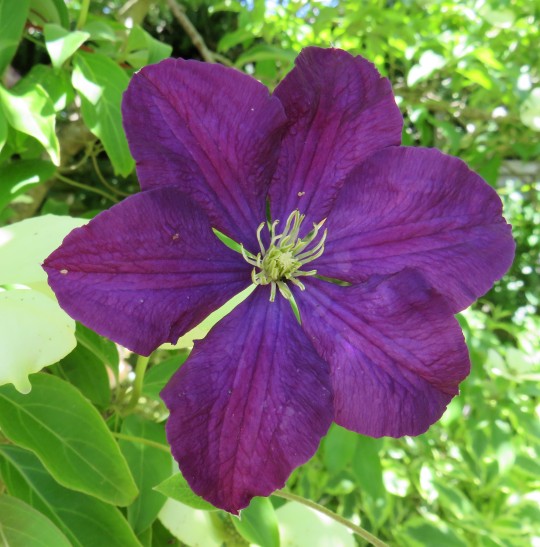
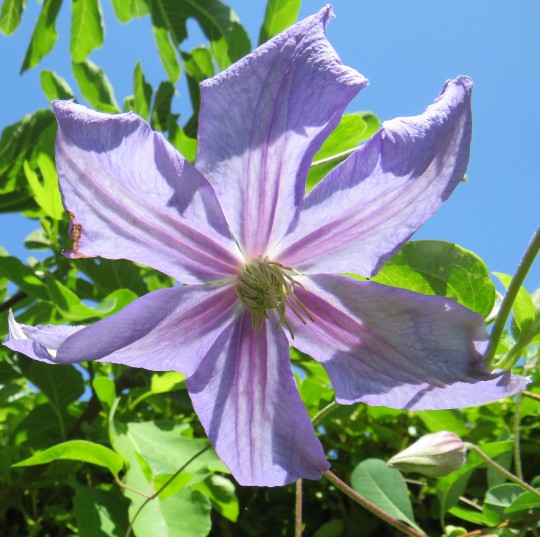
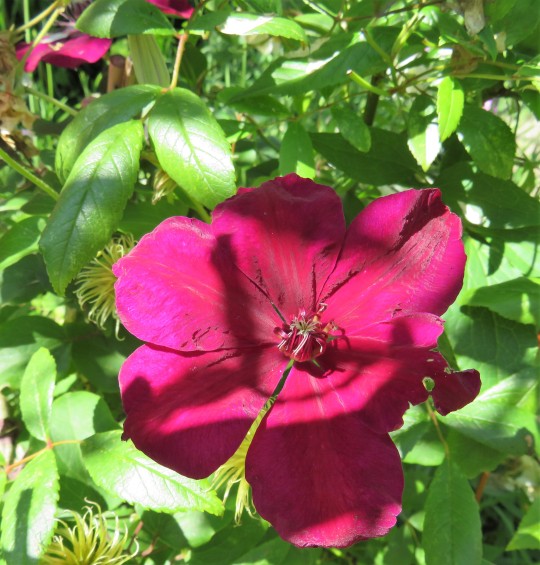

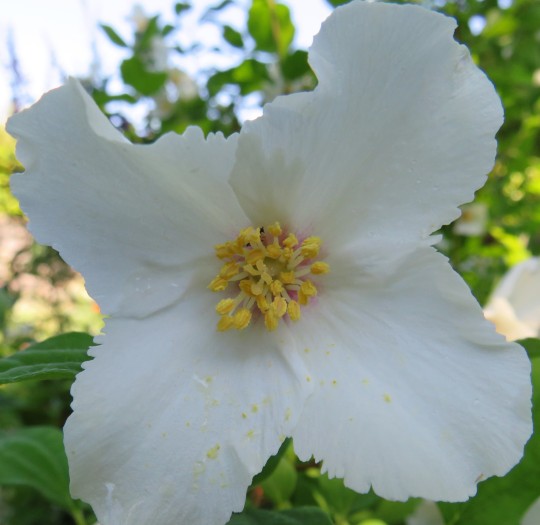
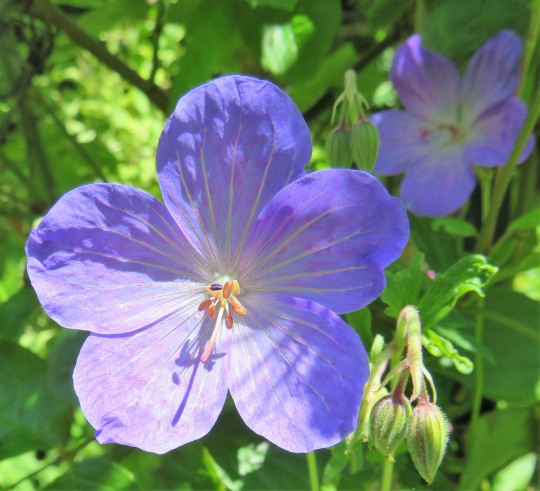

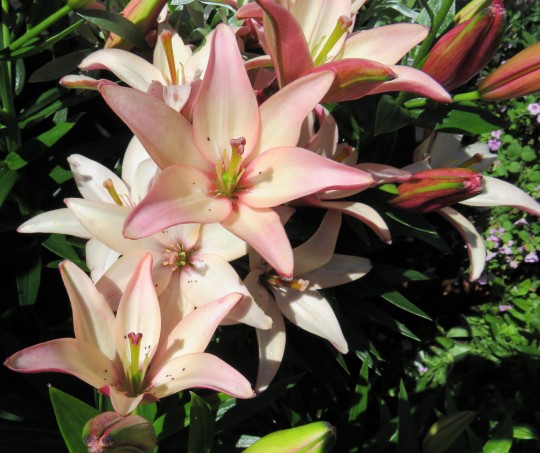
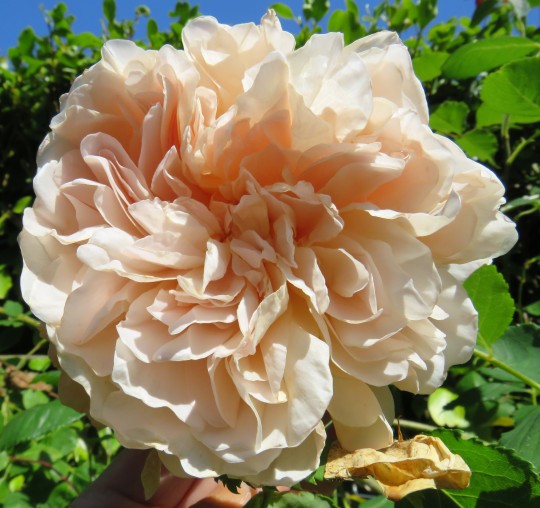
Flowers on June 28th
I stupidly posted last week on my old blog -put that down to old age or incompetence. Looked around yesterday and thought that I really should catalogue the clematis. I did that for the roses a while ago so can name all of them:- not so the clematis.
Anyway, just thought I would try to capture the beauty of a few of the individual flowers out. Three individual bright clematis, then a pure white lychnis (this is often tinged pink) alongside Philadelphus “Belle Etoile” and a blue geranium that scrambles all over the borders. Next two of the lilies that are just coming out in pots, and lastly the rose “Tea Clipper”
Many plants have suffered from the heavy rainfall and so have been slightly beaten up but we hope for better weather in the coming days. Our first tomatoes are just gaining colour so we may be picking in a day or so.
#Garden#Gardening#Lymington#Clematis#Lychnis#Philadelphus Belle Etoile#Geranium#Lily#Rose Tea Clipper#Photography
1 note
·
View note
Photo
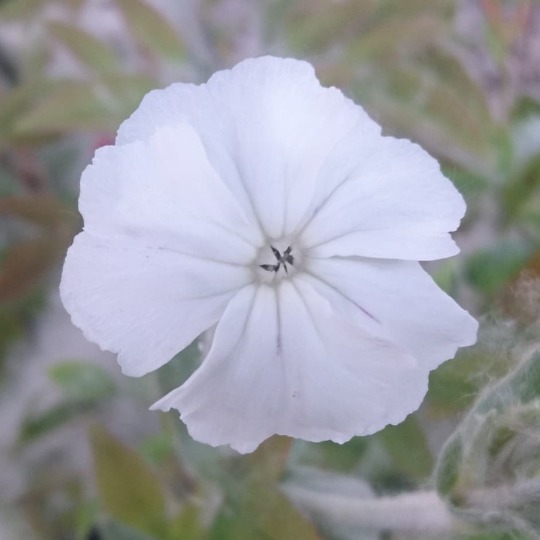
Lychnis coronaria. I fist saw the incredibly bright, deep pink variety and found it striking, the contrast with such a silvery grey stem and leaves. Then I saw this white varity, and loved it just because it was different than what I had seen before, then along came the white Lychnis coronaria with the soft pink center in every flower. I guess I like them all. I have sown all three kinds this year, and will be happy with whatever happens to come my way. #lychniscoronaria #whiteflowers #silverplants #silverplantsofinstagram #ruralgardens #ilikeallofthem #gardensofinstagram #lamacchinafissa #gardenersofinstagram (presso La Macchina Fissa) https://www.instagram.com/p/B_8Wk_qpx0e/?igshid=1wgm3tc3qm8eq
#lychniscoronaria#whiteflowers#silverplants#silverplantsofinstagram#ruralgardens#ilikeallofthem#gardensofinstagram#lamacchinafissa#gardenersofinstagram
0 notes
Text
HOW TO DESIGN WITH WHITE FLOWERS

The color white is always a problem in the garden. It seems gardeners can never figure out how to incorporate it without destroying the color scheme. While it is less of a problem because of the dearth of black flowers, the same situation exists for the color black. This is how you design for these two colors. 1. Place your square or rectangle on top of the color wheel so that the corners are touching specific colors. Any four dots now make a chord. 2. In practice, if not in theory, you can now substitute any single color for the color white. White will make a color chord with the other colors indicated on the square or rectangle. (You can do the same for black but as we don’t have any truly black flowers, it is not really possible to design for true black.) 3. Before you go planting white flowers in your garden however, it is important to read the discussion about the Contrast of Extension. The amount of white in the color balance is as important as the other colors that go with it.
Avoid white flowers in the sunny perennial border whenever possible for your first designs. White is a powerful color and draws the eye to itself quickly and dramatically. Beginners make the mistake of putting white flowers in a garden and then can never quite figure out why the garden never looks good. All colors pale beside white and its effect is to reduce the vibrancy of all other colors. Use magenta sparingly if at all. The plant, Lychnis coronaria 'atrosanguinea' is a major culprit here. It has a wonderful gray leaf, is easy to grow, but has a powerful magenta bloom that doesn't seem to fit with any other combination in the garden. Don't let it into your design because it robs the color from other plants. If you are trying to create an exciting garden, use flowers that contain the hot colors. Reds and yellows, the color of the sun, are considered hot. In the heat of the summer, a garden that is composed of hot colors will feel hotter to work in than a cooler-color garden. When our eye sees the hot colors, it influences the way our bodies react. Hot colors work to physically increase the temperature of the body; why this psychological influence actually works is not clear but all we know is that it does work. Cooler colors – green and blues – are for the relaxing garden. This was the first color lesson I learned. If you want to relax and unwind in your garden after a hard day at work, use cooler colors. If you want excitement, plant the hotter ones. A garden of cooler colors will seem cooler and will cool your body down more than a hot-colored garden. For maximum color interest and excitement, use contrasting two-color chords. Since they are on opposite sides of the color wheel, bright-red geranium flowers held against a dark-green leaf are one of the most popular plants in the garden center. This is why a red rose against a red brick wall is not exciting. Two shades of red are not as exciting as contrasting colors. Now, a red rose against a white clapboard wall or a white or very light pink rose against a red wall, those are another story. For equal excitement, use primary colors instead of secondary colors in your three-color chords
HOW TO WORK WITH FOLIAGE COLOR
This is a book about design, but I would be ignoring an entire range of garden color if I didn’t focus your attention on the fact that leaves have color, too. The full range of greens that is displayed by leaves enables us to design for and with them alone, quite independently of any flower their plants may produce.
IF YOU LOOK at your color wheel, you’ll see that perennial plant leaves, ranging from reddish-burgundy right through to yellow tones, give quite a wide spectrum to play and design with. The same rules for flower-color design hold true for leaf-color design and while the most easily demonstrated gardens are shade-loving hosta gardens, leaf color can be designed in the sunny garden as well.
For example, a golden leafed Hosta 'Golden Tiara' under a tree will lighten up the garden, make it appear brighter than a blue-green-leaved plant such as Hosta sieboldiana 'Elegans'. Visitors to our garden usually fail to notice a huge and wonderful specimen of 'Elegans' because it is right next to the 'Golden Tiara' and some other gold-leaved bloomers. The gold color catches their eye, not the size of plant. They would not notice the gold-leaved plant as much had I not placed a blue one right beside it to create a contrast in colors.
In fact, many garden designers consider leaf color to be more important to the garden than flower color. Leaf color is a constant, it arrives in the spring and for the most part, continues right through the summer until fall frosts knock it down. Flower colors by comparison, arrive for a relatively brief but glorious period and then fade away. Some designers suggest using flower blooms as color accents in the garden rather than the mainstay of color. I’m not one of those given that I enjoy my perennials too much to substitute shrubs and evergreens in my garden to replace my perennials. However, the point that leaf color can be a design element is worthy of note when you have to make a choice about siting or purchasing a plant.
HOW COLOR CONTRAST WORKS IN THE GARDEN
The easiest way to design great color in the garden is to think of the ways in which colors contrast with each other. You will learn how to contrast all the colors in the garden, not only those of the individual flowers. As you read, remember, your house has a color, the background to the garden has a color, and even the sky has an influencing color if the plants are viewed against it.
The dangers and advantages of variegated plants in color design. Variegated plants come to the garden with contrast built right into each leaf. The contrasting color patterns attract many of us to these plants but they do come at a cost to the overall garden design. Let me give you one example. Phlox paniculata, that wonderful garden plant that blooms for a long time in mid-summer and often forms the backbone of perennial gardens, has a particularly heavily variegated form named 'Norah Leigh'. The flower is a pale-pink with a slightly darker eye and the foliage is heavily variegated with cream-yellow and green. In sunlight, the heavy variegation draws out any vibrancy in the bloom, leaving a pale washed out appearing flower stalk. This is one plant that is very difficult to match with other plants. I currently have it beside a Buddleia and some early summer blooming roses in an effort to allow it to stand on its own without heavy competition from other leaves and blooms. I'm not sure this is the best place for it and will likely move it before this book gets to print. In a similar fashion, Chrysanthemum 'Barbara Bush' is a heavily variegated green-and-white-leaved fall mum. All summer, it looks wonderful if kept pruned short and bushy, but when the white flowers appear in the fall, I'm tempted to cut them off. White flowers on a heavily variegated green-and-white leaf disappear into monotony. In your garden designs, add variegated-leaved plants sparingly in sunny gardens.
The Exception: Where You Should Use Variegated Plants In shady gardens however, variegated plants are treasures that provide some color and contrast all summer long and for this reason they are to be treasured. The wonderful variegations on plants such as Brunnera, Hosta and Pulmonaria almost demand to be let loose in the shady garden. Use them as much as
possible.
Contrast of Hue This is perhaps the simplest of the contrasts in the garden. We immediately and intuitively see the difference or contrast between red and green or between yellow and red. This contrast is quite clear and easy to understand. As the colors move away from the primary colors (red, blue, yellow) the contrasts become progressively weaker. A pale yellow does not contrast as much with a pale pink as does a bright yellow with a bright red. I note on the starred color wheel that different shades of a color can be designed for by simply increasing the size of the cardboard shape so that all the corners touch that ring in the circle.
Contrast of hue assumes that all the colors in the garden are of the same intensity. Colors with different intensities or values, as artists like to say, are described under the light/dark contrast.
Light/Dark Contrast Well, You know what is light and what is dark in the garden. What gardeners often fail to appreciate is how the light influences the way we all see colors. The fragile blue-pinks of spring-blooming Pulmonaria are much more intense in the semi-shade of a tree with emerging leaves than it is under the full glare of a full-sun garden. The light does not wash out the delicate colors in the part shade as it does in the full sunshine. It is easy to fail to appreciate how a spark of light that regularly crosses a garden can illuminate or darken the color of a plant. What you see in a catalog is often not what we see in our gardens. The major problem for garden designers is fitting the contrast in light/dark to the different hues of plants. What intensity does a ‘Hyperion’ daylily bloom at in its old-fashioned clear-yellow tones and what intensity is a-yellow blooming Coreopsis? Do they match or is there too much of a difference for them to exist together in the garden? Unfortunately, without a good eye for color or without art training (it is possible to learn such things), the garden designer will continue to hit and miss when it comes to the subtlety of light and dark contrast with closely matched flower colors. It is perhaps for this reason that some of our finest garden designers are visual artists on canvas as well as in the garden.
Cold/Warm Contrast There is no question in the minds of color theorists and industrial designers that colors influence the way we feel heat and cold. Rooms that are painted in “hot” colors of reds and yellows will be experienced without complaints from those in the room more so than rooms painted in “cool” temperatures of blues and greens.
In other words, the hot color made the room seem hotter, even when it was really cool and cool colors made the room seem cooler even when the room was at the right temperature. You perceive temperature based on color.
For some reason, people see and feel the heat of the color and our bodies react to it in a physical manner. Bright reds and yellows will therefore increase the heat in the garden while cooler blue and soft greens will cool it down. This is a relative concept and it should be noted that while there are extremes of heat and cold in color, the position of the colors influences how they are seen. Let me illustrate. The right hand side of the wheel is the hot side. A color such as yellow is quite hot and the colors cool down as they progress down the wheel towards blue. Yellow is much hotter than orange. If these two colors are seen together, then yellow is hot and orange is cool, relatively speaking. However, if we compare orange and red, we see that orange is hotter and red is the cooler color. Orange becomes hotter when in the company of a cooler color and cooler when in the company of a hotter color. The contrast then is all important. You can make a relatively cool color such as violet or purple hot by putting it next to a flower that is a clear blue. In practice, this means that in designing a cool garden of blues and violets, the addition of a soft pink will add a touch of heat, of excitement to emphasize and lend some energy to the garden. One does not have to add yellow to increase the energy or heat level. It is a question of relative energy. If one wants a bit of energy in a cool garden, then one can determine that energy by increasing or decreasing the numbers of plant or the relative heat value of the plants involved. For example, adding one or two soft-pink plants to a yellow (hot) garden will cool it down while adding a blazing yellow to a blue garden will create a hotter garden. Remember, it is all relative. If my garden is designed around reds, violets and oranges, a touch of yellow will still add relative energy to the garden and create a warm-cool contrast. The yellow is hot while the oranges will be cool. Similarly, I could add a touch of blue Nepeta to a stunningly hot bed of orange and red Hemerocallis to cool it off and add contrast.
Color is relative. The same color can be hot in a cool colored garden but cool in a hot colored garden
Complementary contrast I’ve already touched on complementary colors but it is useful to consider some other qualities of contrasting pairs of complementary colors when applied to the garden. Remember that these colors are opposite each other on the color wheel. Flowers that are yellow and violet are also a perfect example of a light/dark contrast. Yellow Oenethera and violet Nepeta are not only complementary, they are light and dark. Reddish-orange and blue-green are complementary but are also the most extreme examples of hot and cold in the garden.
Contrast of Saturation Pure colors, as you'll see on the color wheel, are rare in the garden. Unfortunately, flower colors rarely conform to the designer’s desires for clarity and consistency. The vagaries of the weather and growing conditions change flower color from day to day and season to season and prevent gardeners from designing in pure or consistent flower colors. Keep the following points in mind when examining those wonderful flower pictures. * Any flower that is paler than another (as if white were added to the original color) is cooler. Pale flowers are cooler than more intensely colored flowers. * Any flower that adds violet or “black” to its mix increases in warmth. Darker colors are warmer. * Green colors are very important in this as the darker green the leaf, the more intense will be the contrast with the surrounding flowers. A perfect, although non-garden, example of this is the new breeding of Christmas poinsettia plants. The newer varieties have much darker leaves which in turn makes the red bracts stand out so much more. This is a perfect example of contrast of saturation.
If you have a choice between a light-green leaf on a plant or a variety with a darker-green leaf, the darker-green-leaved will provide more contrast with the flower making the bloom explode with light and color.
The lighter-green leaf is useful if the leaves are the primary color source. The best example of this is the hosta family. We pick darker and lighter leaves to work together in the garden regardless of the flower color. We use pale or less-saturated green-colored leaves and grow them next to darker or moresaturated leaves to increase the contrast.
Contrast of Extension While this sounds complicated, it is pretty simple to understand the basic principle. The primary question that contrast of extension is answering is, “What is the proportion of this color that I need to balance the proportion of that color?” This is perhaps one of the most important questions in the field of garden color design. An overpowering abundance of yellow in the fall garden is one such problem. The designer has far too many hot yellow and orange Coreopsis, Heliopsis, Heleniums and Solidago to work with when compared to the other softer colors. Balance the colors in the garden using these numbers (originally designed by Goethe, one of the last truly great Renaissance figures) as follows: * Yellow = 9 * Orange = 8 * Red =6 * Violet =3 * Blue =4 * Green = 6
As an example, the complementary colors of violet to yellow give a ratio of 3:9 (or 1:3) Because yellow is so much brighter than violet, use one part of yellow to equal three parts of violet. (Reverse the ratio to get the correct amounts) In the garden, use 3 square feet of violet blooms to balance the color provided by 1 square foot of yellow blooms.
YELLOW IS much brighter and carries more power. Orange, with a value of 8 and blue with a value of 4 is a simple ratio to calculate. At 8:4 (orange:blue) the garden requires twice as much blue to balance an area of orange. Yellow (9) and red (6) combine at 9:6 or 3:2 so the garden requires 3 parts of the darker red to balance 2 parts of the brighter yellow.
You will always require less of the brighter color to balance the darker color in your garden. Having said all of this, the reality in the garden is that this is never a perfect science so relax and enjoy yourself while you work out your own preferred colors.
A PLANT of Coreopsis might be several years older than an Eupatorium or Aster and carry more flowers. Growing a well-designed flower garden is as much an art as it is a science. Don’t think in terms of individual plants, think in terms of square footage of blooms or areas of contrast of blooms.
Think in terms of wide swaths of color as do painters rather than the individual flowers of gardening imaginations.
I have to point out that the ratios designed only have validity if the flower color contrast of hue is the same. In other words, a bright-blue fall aster has to be compared to a bright-yellow Helenium and not a much softer-yellow Solidago. When a color is paler, it will require a corresponding increase in ratio or area of bloom to balance a more intense color. This then is not an exact science but rather more of a guideline for the gardener. Don’t use tape measures to evaluate the flower sizes and relative contrasts of extension but do use your eyes and your judgments. It is this judgment that needs practice over the years to determine a good color proportion.
As a last note, white is not mentioned in this chart but you can very quickly see that it will have a much higher number than even yellow. This means that a little white goes a very long way in the garden when compared to the rest of the flowers.
0 notes
Text
Focus on plants for the world horse welfare artisan garden
In keeping with their signature ‘wild and wonderful’ style, garden designers Adam Woolcott and Jonathan Smith have selected between 50-60 different species of wildflowers and wild grasses, plus trees and shrubs which are all British natives. for the World Horse Welfare Garden at this year’s RHS Chelsea Flower Show. Almost 1,000 plants will be grown in total, with 300 cultivated in Adam and Jonathan’s own garden in Hertfordshire.
The garden is a traditional wildflower garden and will tell the story of a real horse rescued from a small, derelict stable and nursed back to health under World Horse Welfare’s care, now living in a bright, open meadow where he can thrive and continue his journey to re-homing. The garden will celebrate the charity’s 90 years of helping horses and introduce its work to show goers and television viewers alike. The aim is to shine a spotlight on ‘invisible’ horses around the world whose suffering goes unnoticed or ignored.
Whilst planning the garden, the designers were keen to use a feature tree in the right hand corner of the garden to add height and interest. The choice was limited as it couldn’t be a cultivar and had to be ‘horse friendly’ in this part of the garden. The first choice might have been a horse chestnut based on the fact they they look so impressive in May but are harmful to horses and so opted for a sweet chestnut tree (Castanea sativa), a type which coincidentally happens to grow at the charity’s headquarters in Norfolk.
Ragwort (Senecio jacobea) is the most poisonous plant to horses and included in the Injurious Weeds Act 1959. As one part of the garden is designed to show an unsuitable space for horses, the designers and charity felt appropriate to include it. Using both horse friendly and horse harmful plants is intended as an educational tool to help demonstrate both poor and good horse welfare.
Adam and Jonathan have recycled some wildflowers from client compost heaps, potted them on and now have some wonderful specimens growing in their own garden which will be ready for the Show come mid May. One favourite is greater stitchwort (Stellaria media), a gloriously understated pure white flower that scrambles up between other plants. It’s a perfect plant for use on the edges of meadows and will be planted towards the front of the garden on the right hand side.
Ragged robin (Lychnis flos-cuculi) is a great wildflower for damp meadows so a good choice for planting near the meadow stream. It has a beautiful delicate pink flower and was one of the stars of the Chelsea Flower Show 2006 when it caught the eye of show goers and the media. Another meadow wildflower winner has to be Ox-eye daisy (Leucanthemum vulgare). Foxgloves (Digitalis purpurea) are highly poisonous to horses and it’s the wild native purple form that will be planted in the neglected horse area. This area will not be overly pretty; it needs to evoke a certain menacing darkness symbolic of the terrible circumstances that these invisible horses find themselves in.
0 notes
Photo
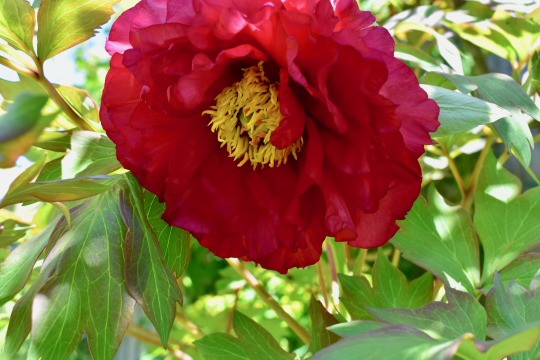
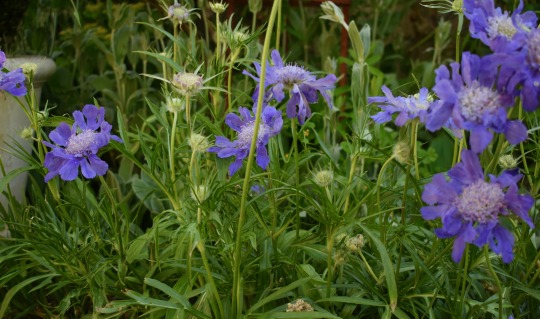
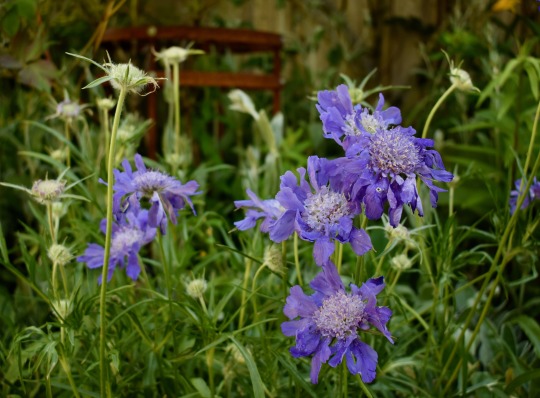

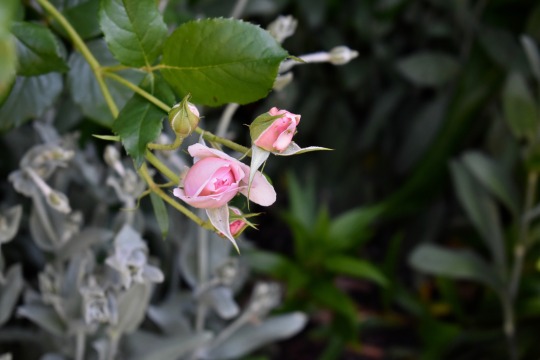
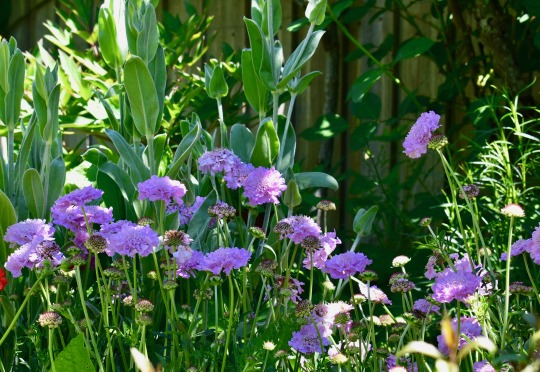

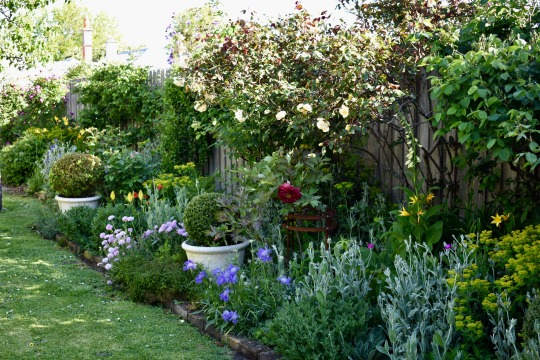
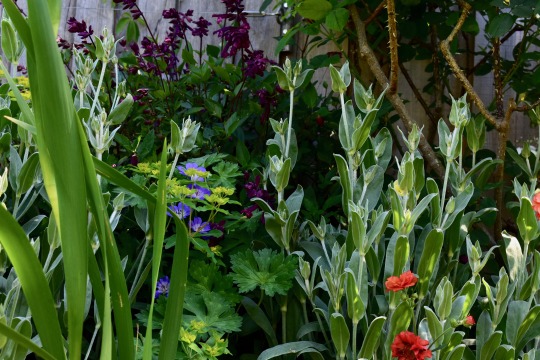
THE LONG GARDEN NOW
This is the first stage of the flowering in the long garden - the peonies, golden day lilies, vermilion geums, yellow kniphofia, cranesbill geraniums, lime euphorbia, pink and blue scabiosa and ‘Lady Hillingdon’ and ‘Golden Wings’ roses.
The next phase is dominated by the four large pink flowered ‘Fantin-Latour’ fence roses, and also Austin roses - ‘Heritage’, ‘Grace’, ‘Charlotte’ and ‘Mary Rose’ - and below, the repeated clumps of blue Salvia x superba ‘Blauhugel’ which create a rhythmic ‘blue beat’ along the whole. The abundant self seeded plants of silver leafed Lychnis coronaria also add a bright pink cohesion.
16 notes
·
View notes
Photo

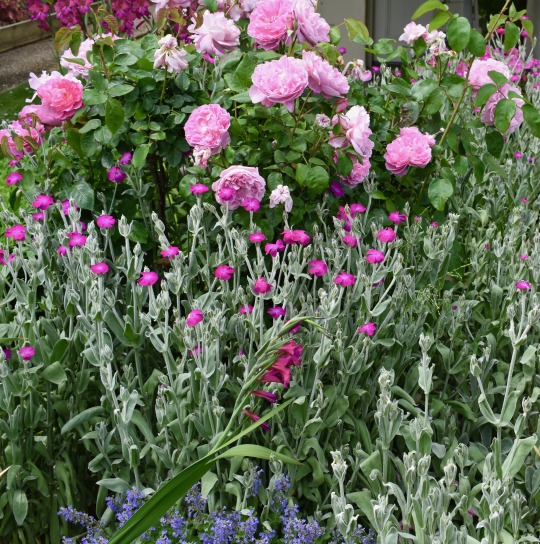
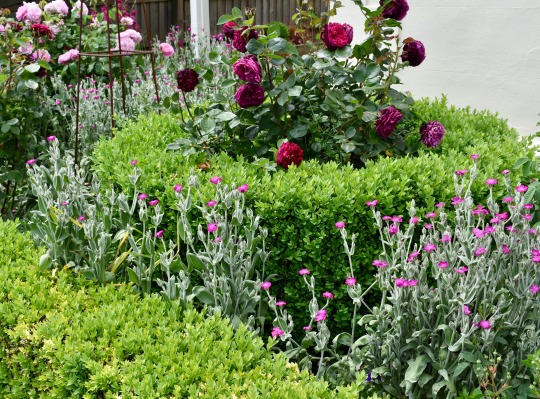

THE FRONT GARDEN NOW (discussion for gardeners)
The front garden is assembled with plants whose flowers are in the pink and blue spectrums, and when this combination is set against the bright green box, the whole scheme becomes visually linked and the colour is set off by the pale cream facade of our house..
I have herbs planted amongst the old and David Austin roses (a must for an old country cottage garden don't you think?) - lime oregano, thyme and catmint - as well as hardy blue salvias ( S.‘African Skies’, S.‘Bergaarten’, Salvia x superba ‘Blauhugel’, and Salvia lycoides ‘Blue Lightening’ which is along the footpaths. I have just thought I should grow some dill there as well.
I always try to make my gardens a little wild looking and free-form within an ordered bigger scheme so the plants themselves can make their own portrait placings. I love self seeded plants as they give the effect that nature intended and they can always be pulled out if you don't want them. The large presence of the grey leafed Lychnis coronaria ‘Dusty Miller’ is evident in the photographs here. Some these will be pulled out to make way for annuals after flowering.
Of course having most things blooming that only last a very short time gives a prettier result. A more judicious gardener would make sure there was a succession of flowering activity through the season. I am always trying to achieve this as well. The pink ‘Maitre d’Ecole’ and ‘Versicolour’ Gallica rose bushes will flower next and I am now putting in place pink annual cosmos, honeywort and white cleome and orange gladioli for summer. Later I will add the zinnias that I will first grow in pots from seed for autumn. I will also sow successive plantings of cosmos so it can flower right through to autumn and provide flowers for the house. The good thing about the pink species gladioli (Gladioli communis subs. Byzantinus) flowering now is that you can take away their foliage after they have finished flowering and it does not seem to affect their bulbs and blooming capacity the following year (unlike other bulbs).
The ‘Blue Lightening’ salvia flowers right through spring and summer and autumn if you cut it back after the first flowering. An amazing drought tolerant plant but it can be invasive if you let it go. The ‘African Skies’ salvia also flowers constantly and it is a most attractive small bush (with beautiful bright green leaves), especially if you keep pinching it back in spring. I am wondering if the tiny lizards that live in the hot front garden eat the flowers of this plant as they are sweet smelling and often seem to disappear overnight.
Last autumn we spread a generously quantity of minced oak leaves from the two huge trees which hang over our fence all over the front garden as mulch. I am amazed at the vigorous and improved growth of the plants this season and the soil’s water retention. The roses have been particularly good this year, and that is without the expensive Sudden Impact for Roses fertiliser that I have been spreading for many years now. I thought I would try not using it this year to see if it made a difference. Instead I applied Dynamic Lifter pellets and some roses were also fed with a little duck compost that Danny acquired for his vegetable garden. I suspect the latter has made a huge difference too.
2 notes
·
View notes
Photo

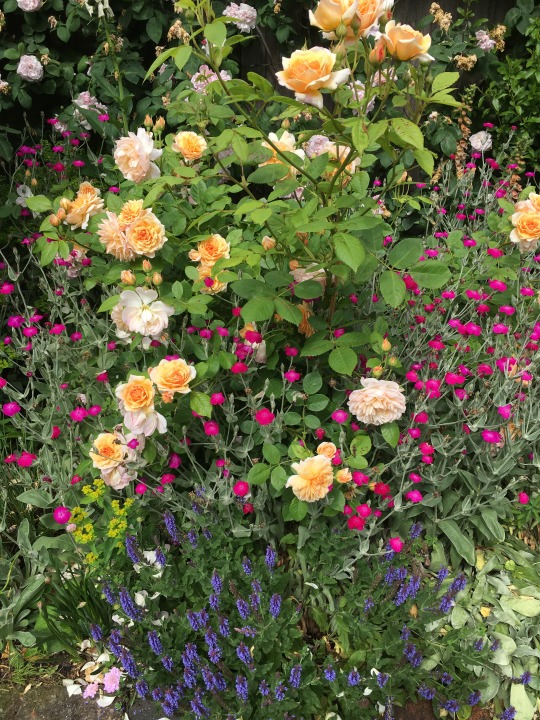
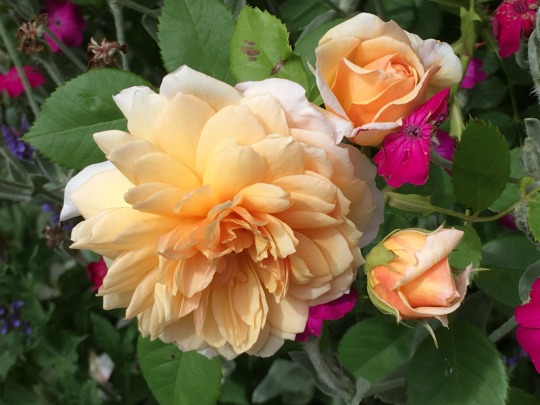

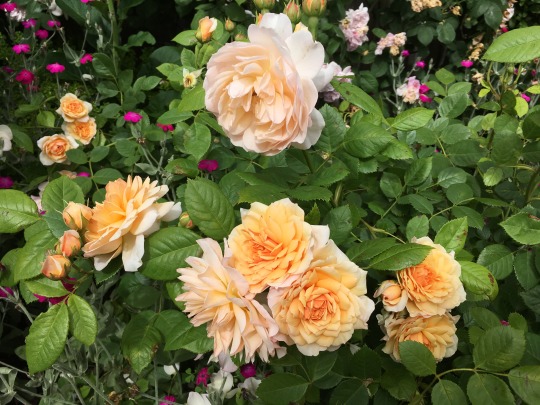
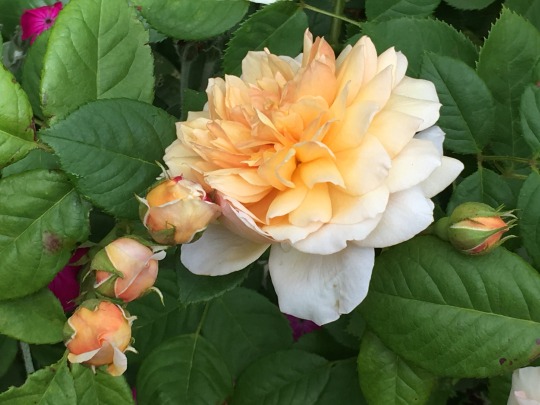
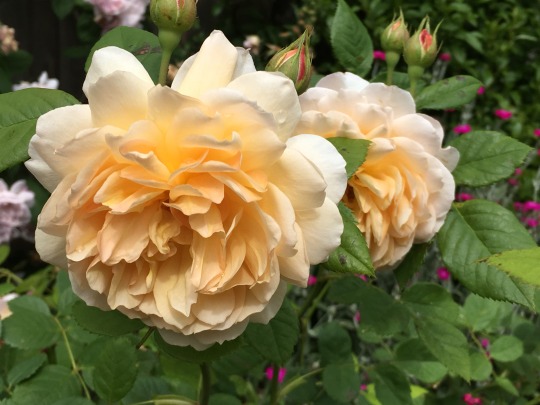
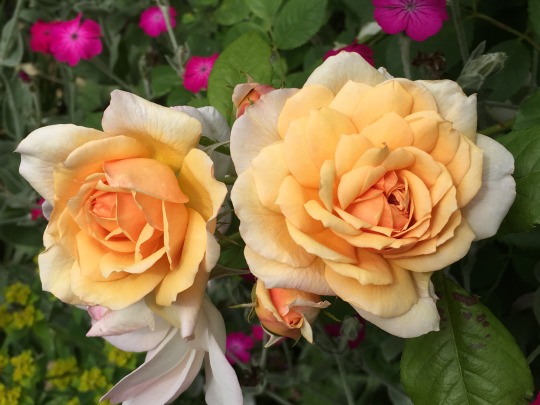
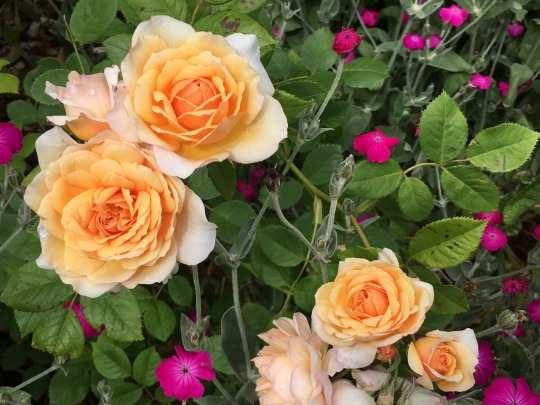
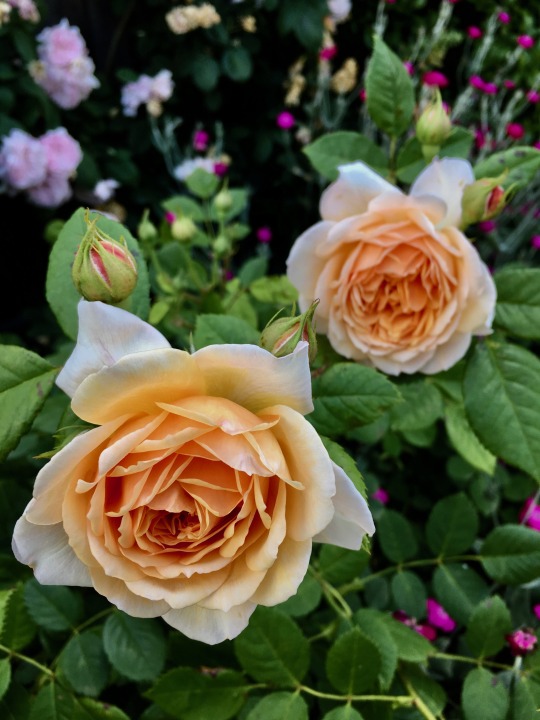
THE LOVELY ‘GRACE’ ROSE
This later flowering David Austin rose with light green foliage is one of his best. It is such an interesting rose that has taken a long time to build up. It hasn’t reached full height yet. The unusual blooms are lovely at all stages, especially set against the light foliage, and they have a clean fruity scent. I love this rose with the bright pink Lychnis coronaria.
1 note
·
View note
Photo
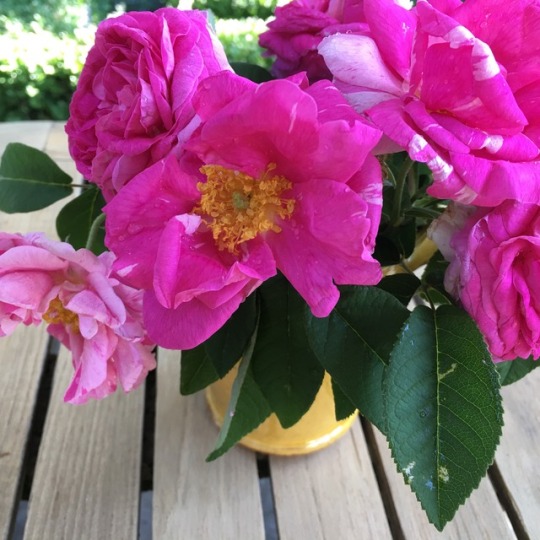


THE FRONT GARDEN ON A WARM LATE NOVEMBER MORNING
The old roses are out. ‘du Maitre d’Ecole’ is the bright pink at the back and in the foreground is Rosa Mundi, the striped beauty from the 16th century. Some of these blooms have reverted back to the pink parent plant, Rosa Versicolour. The little rose on the right that has almost finished blooming is the pale pink ‘de Meaux’, a miniature Centifolia rose from the 18th century. There is also hot pink lychnis coronaria, or rose campion, an essential perennial plant, in front of the lavender that blooms mid December.
8 notes
·
View notes